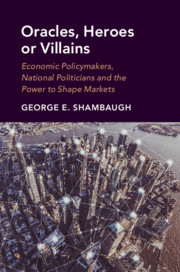 Oracles, Heroes or Villains
Oracles, Heroes or Villains Book contents
- Oracles, Heroes or Villains
- Oracles, Heroes or Villains
- Copyright page
- Dedication
- Contents
- Figures
- Preface
- Acknowledgments
- Abbreviations
- 1 Reaching for the Bazooka
- 2 Preferences, Power and Predictions
- 3 The Argentine Tango
- 4 The Federal Reserve Goes Political
- 5 A Greek Tragedy
- 6 Managing Markets in Turbulent Times
- Bibliography
- Index
3 - The Argentine Tango
Published online by Cambridge University Press: 09 September 2019
- Oracles, Heroes or Villains
- Oracles, Heroes or Villains
- Copyright page
- Dedication
- Contents
- Figures
- Preface
- Acknowledgments
- Abbreviations
- 1 Reaching for the Bazooka
- 2 Preferences, Power and Predictions
- 3 The Argentine Tango
- 4 The Federal Reserve Goes Political
- 5 A Greek Tragedy
- 6 Managing Markets in Turbulent Times
- Bibliography
- Index
Summary
Like the bittersweet drama of tango dancers performing on Calle Florida for shoppers leaving Buenos Aires’ posh Galerías Pacífico shopping center, Argentina’s political and economic leaders stepped out of Latin America’s sorrowful “lost decade” of the 1980s with a series of dramatic policy changes that led the country through grand successes, devastating failures and postcrisis resurgences. Like the dancers shifting to changes in musical tempo, Argentine presidents and ministers of the economy responded to fluctuations in global markets and domestic politics with dips and twirls, driving forward and occasionally reversing direction with great fanfare. Their moves generated both praise and scorn, winning Argentina the diverse imprimaturs – at different moments in time – of “poster child” of the Washington Consensus, “defaulting pariah” of international bondholders, “vanguard” of Latin American populism and the “victim of vulture investors” that threatened to undermine debt restructuring agreements around the globe.
Keywords
- Type
- Chapter
- Information
- Oracles, Heroes or VillainsEconomic Policymakers, National Politicians and the Power to Shape Markets, pp. 40 - 102Publisher: Cambridge University PressPrint publication year: 2019
